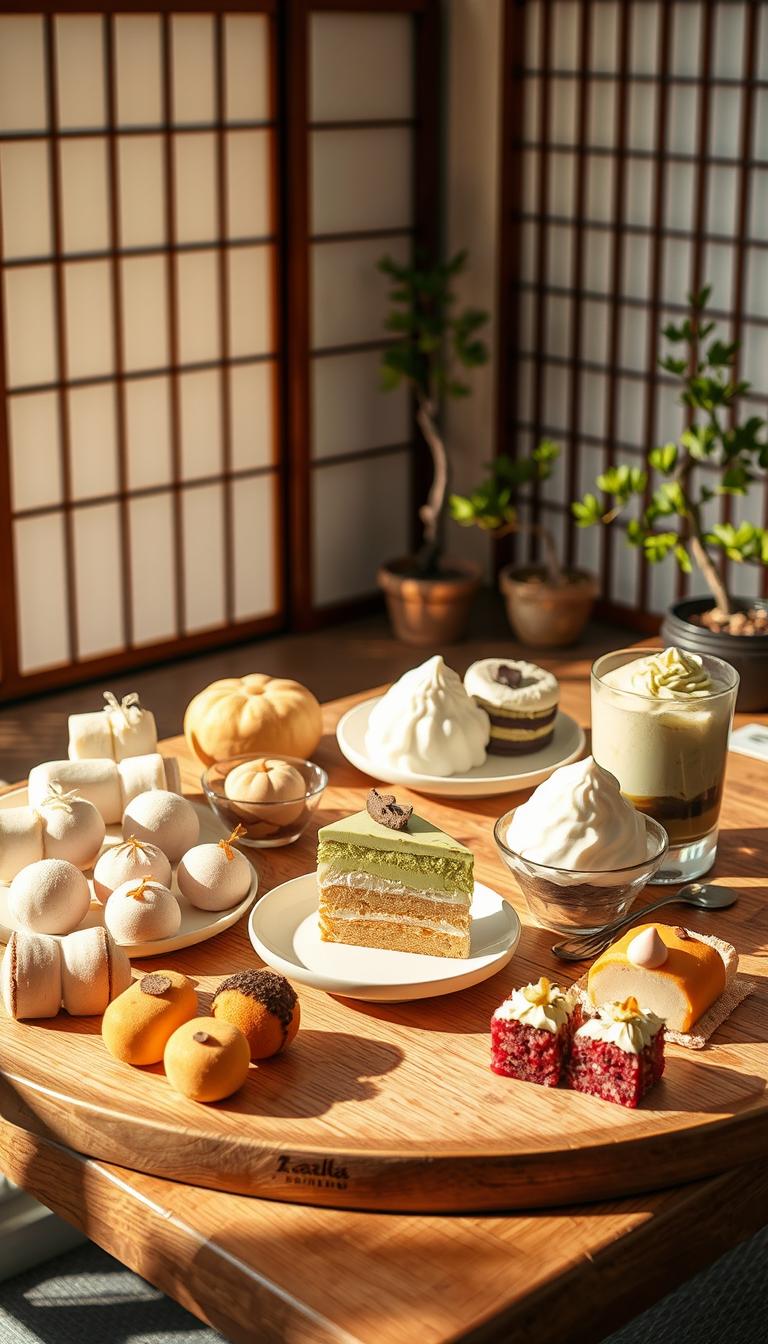Imagine stepping into a world where desserts are not just food, but an art form. They tell a story of culture, tradition, and seasonal beauty. Japanese desserts, or Japanese sweet food, have a long history, over two millennia.
These desserts are more than treats. They are a sensory experience that shows Japan’s love for nature, balance, and beauty. From traditional wagashi to modern sweets, each bite tells a story of culinary evolution.
Japanese sweets differ from Western desserts. They are not too sweet, use natural ingredients, and are visually stunning. The way these sweets are made shows Japan’s attention to detail in cooking.
Japanese desserts change with the seasons. Spring brings sakura mochi, while winter offers adzuki bean treats. They invite you to see food as art, connecting you to Japan’s rich culture.
Understanding the Cultural Significance of Japanese Sweets
Japanese desserts are more than just treats. They are a deep expression of culture, tradition, and history. Each dessert tells a story that links generations and honours Japan’s rich heritage.
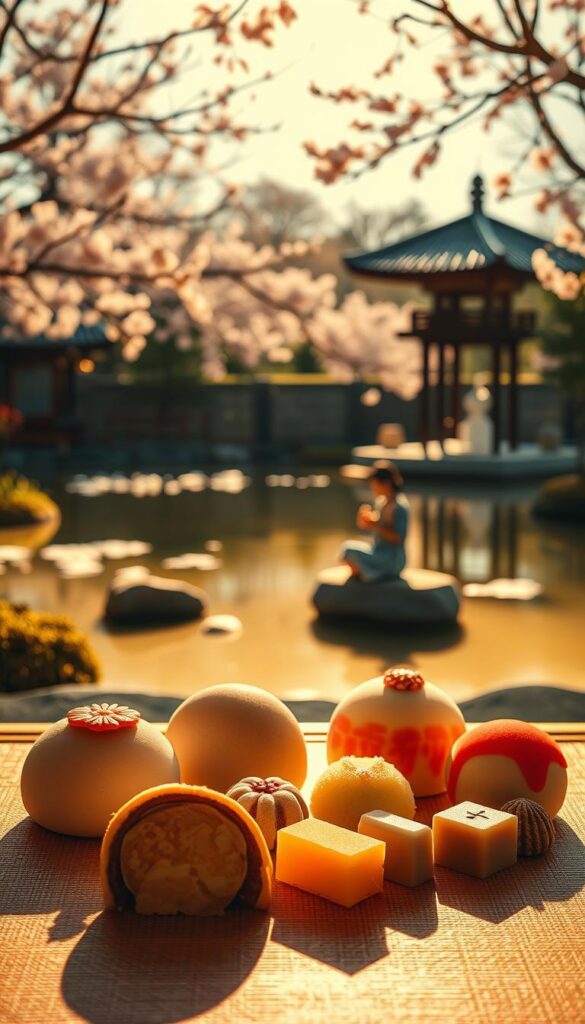
Japanese sweets are not just about taste. They are about art, seasons, and community. From the delicate wagashi in tea ceremonies to festive treats, they speak a complex cultural language.
The Role of Desserts in Tea Ceremonies
In traditional tea ceremonies, desserts are key. Wagashi are made to match the tea’s flavour, creating a perfect taste experience. These sweets show the detail and skill in Japanese cooking.
Seasonal and Festival Connections
Japanese sweets change with the seasons. Spring brings sakura mochi, and autumn has chestnut sweets. Each festival has its own sweets, showing cultural values and traditions.
Religious and Traditional Importance
Many Japanese sweets hold religious and traditional value. They are given as gifts, used in ceremonies, and mark important life events. Their sweetness and beauty reflect Japan’s spiritual and artistic values.
The Art of Wagashi: Traditional Japanese Confectionery
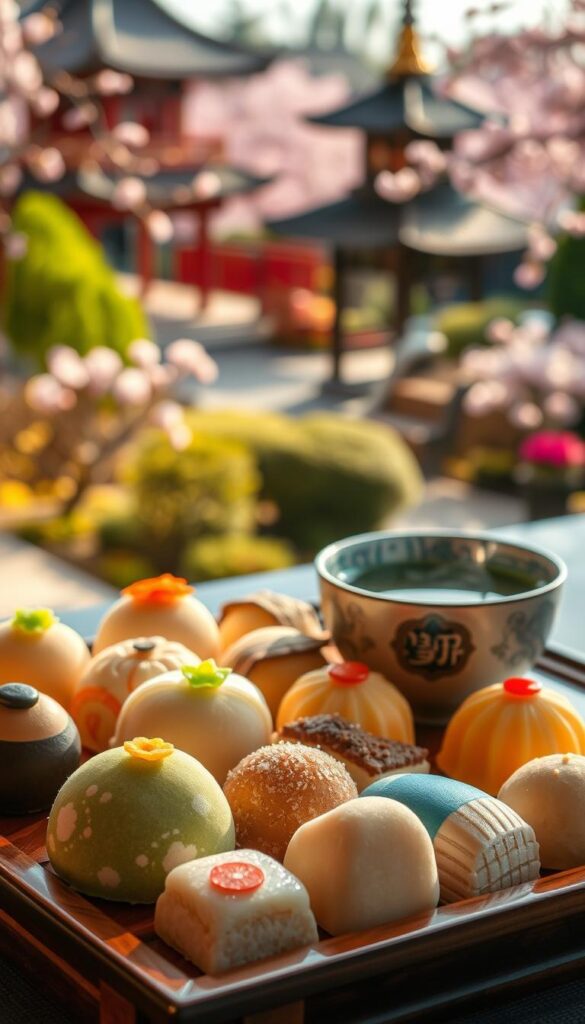
Wagashi is the top of Japanese sweets, a true art form. It turns simple ingredients into stunning edible works. These sweets have a long history, dating back over 1,200 years to the Nara period.
Each wagashi piece tells a story with its design and making. Skilled craftsmen spend years mastering the art. They use glutinous rice, sweet bean paste, and natural dyes to create these tiny masterpieces.
Wagashi changes with the seasons. In spring, you might find sakura mochi with pink hues. Autumn brings momiji manju with designs of changing leaves. These sweets are more than treats; they show Japan’s natural beauty.
Ingredients like azuki beans and agar are key to making real wagashi. New tastes like chocolate and fruit have been added. Yet, the art behind these sweets remains unchanged for centuries.
The Japanese proverb “For mochi, go to the mochi shop” shows the respect for wagashi makers.
Wagashi is loved in Kyoto’s old tea houses and Tokyo’s modern cafes. It charms people with its mix of skill and beauty.
Essential Ingredients in Japanese Desserts
Exploring Japanese dessert recipes means understanding their key ingredients. These ingredients are what make their flavours and textures special. Traditional recipes use unique components that give them their distinct taste and look.
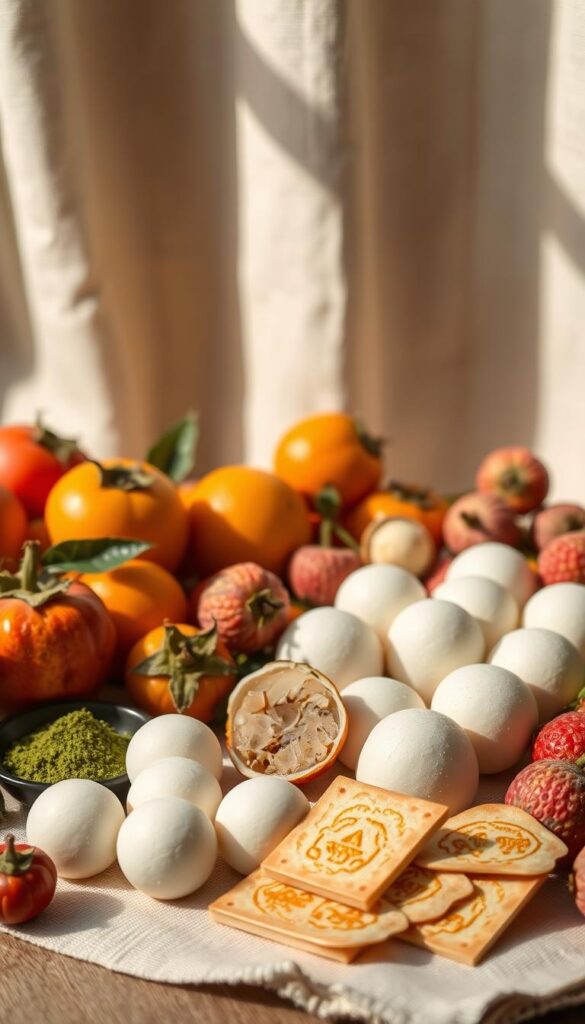
Japanese sweets are special because of their chosen ingredients. Each one has a deep cultural history. They tell stories of old traditions and local specialties.
Matcha and Green Tea Components
Matcha, a finely ground green tea, is key in many Japanese desserts. It adds a deep, earthy taste and lots of antioxidants. This ingredient turns simple desserts into something truly special.
Sweet Bean Paste Varieties
Sweet bean pastes, like red bean (azuki) and white bean, are essential. Anko, the sweet red bean paste, is used in many traditional sweets. It gives them a smooth, sweet filling that’s unique to Japanese sweets.
Rice-Based Ingredients
Rice flour and glutinous rice are vital in Japanese desserts. Mochi, a soft rice cake, shows how these ingredients create special textures. From delicate sweets to chewy rice cakes, rice is incredibly versatile in making sweet treats.
Popular Types of Japanese Desserts
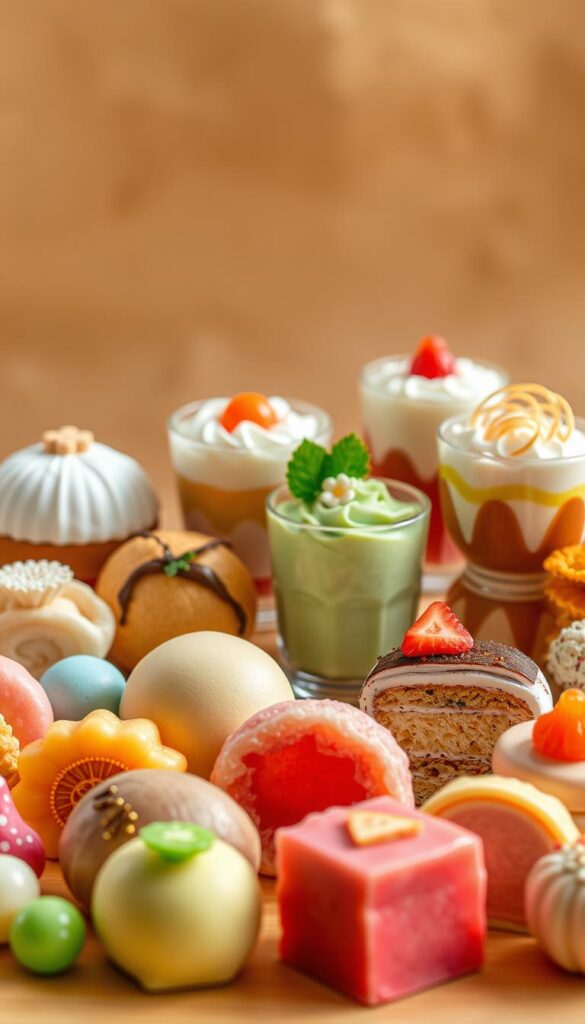
Exploring Japanese desserts shows a wide range of traditional sweets. Mochi is well-known worldwide, with a history dating back to the Jomon Period. It’s made from glutinous rice, showing the skill of Japanese confectionery.
Dango is another favourite, served on bamboo skewers with three to five balls. They come in many flavours, like mitarashi dango with a sweet-soy glaze. Hanami dango, with its colours, is a hit during cherry blossom season.
Dorayaki is a unique treat, like a Japanese pancake sandwich. It’s filled with sweet red bean paste and found in tea shops and stores. Daifuku, meaning “great luck,” is a ceremonial gift, often filled with strawberries and red bean paste.
Wagashi lovers will enjoy yokan, available in soft mizu yokan and firmer neri yokan. Each dessert reflects Japanese tradition, changing with the seasons and telling cultural stories.
Modern Japanese Sweet Innovations
Japanese desserts have changed a lot in recent years. They now mix old techniques with new global trends. Today, we see a blend of classic tastes and fresh ideas that excite people all over the world.
Modern Japanese sweets show amazing creativity. Desserts like mochi ice cream have become hits globally. They mix old traditions with today’s tastes, showing a culture that values its past but also looks to the future.
Fusion Desserts: Global Culinary Crossroads
Japanese pastry chefs are making old sweets new again with fusion ideas. They combine traditional Japanese ingredients with Western dessert methods. This creates unique sweets that draw in food lovers looking for something special.
Contemporary Interpretations
Today’s Japanese sweets often use plant-based and low-sugar options. This is for people who care about their health. Seasonal sweets, or “gentei”, celebrate special times and show off Japanese sweets’ artistry.
Popular Brands and Chains
Brands like Minamoto Kitchoan and Toraya are leading the way in Japanese sweets. They turn traditional sweets into modern treats. They keep the sweets true to their roots but also make them appealing to everyone.
Regional Specialities and Seasonal Treats
Japan’s 47 prefectures are a treasure trove of unique desserts. Each region’s sweets tell stories of local traditions and seasonal changes. They show the rich cultural heritage and creativity of Japan’s cuisine.
In Kyoto, desserts like wagashi are famous for their beautiful designs. These designs change with the seasons. For example, spring brings sakura mochi wrapped in cherry blossom leaves. Summer treats like kuzu manju offer a refreshing coolness.
Desserts vary greatly across Japan. Hokkaido celebrates sweet potato treats, while Okinawa has desserts with tropical ingredients. These specialities highlight how food is deeply connected to local identity and nature.
Seasonal themes are key in Japanese sweets. Autumn sweets use chestnuts and sweet potatoes for warm flavours. Winter desserts, like adzuki bean preparations, warm the body and soul.
Each japanese dessert is a miniature artwork, reflecting the region’s landscape, climate, and cultural traditions.
Exploring Tokyo’s depachika or a small sweet shop reveals the beauty of Japanese desserts. They are more than food; they celebrate local craftsmanship and the beauty of each season.
The Art of Making Traditional Japanese Sweets
Making traditional Japanese sweets is a skill that needs great care and precision. It’s a delicate art passed down through generations. It combines cultural heritage with culinary skill.
Artisans of Wagashi spend years learning how to turn simple ingredients into beautiful sweets. These sweets are more than just desserts. They are edible expressions of the seasons and cultural values.
Crafting Techniques
Preparing traditional Japanese sweets involves special methods. Techniques like moulding, steaming, and gelling are key. They give wagashi their unique textures and shapes.
Artisans use their hands to create patterns that look like nature. They might make shapes that look like cherry blossoms or autumn leaves.
Essential Tools and Equipment
Wagashi makers use tools passed down through centuries. They have wooden moulds, fine brushes, and precise cutting tools. These tools help them make sweets from rice flour, sweet bean paste, and natural colours.
Now, modern technology helps them create even more detailed designs. This lets them make more complex patterns and shapes.
Preservation Methods
Keeping wagashi fresh is important. Most sweets are best eaten within a few days. Storing them in cool, dry places helps keep their texture and taste.
This way, each piece stays true to Japanese culinary art. It ensures that every sweet is a masterpiece.
Health Benefits and Nutritional Aspects
Japanese desserts are not just tasty. They also offer health benefits that Western sweets don’t. These sweets use natural, plant-based ingredients. This makes them good for your health.
Wagashi, a traditional Japanese dessert, is known for its good nutrition. For example, daifuku mochi has 235 calories per 100g. It has a good mix of protein, carbs, and little fat. This makes it a healthier choice than many Western sweets.
Azuki beans are a key ingredient in many Japanese desserts. They are full of dietary fiber, B vitamins, and minerals. Azuki beans also have polyphenols that may help prevent aging and improve overall health. They have iron too, which helps with blood health and prevents anaemia.
Agar, another important ingredient, is very healthy. It has almost no calories and lots of dietary fiber. Agar can help your gut health, lower cholesterol, and make you feel full.
It’s good to enjoy these sweets in moderation. Eating them with green tea can boost their health benefits. The antioxidants in green tea work well with the wagashi’s polyphenols. This can help control blood sugar after eating.
Pro tip: Choose varieties like mizu-yokan or kuzukiri for lower-calorie options that don’t compromise on taste.
Where to Find Authentic Japanese Desserts
Exploring authentic Japanese desserts is a thrilling food adventure. You can find these treats in Japan or through international options. There are many great ways to enjoy these sweet delights.
In Japan, the top spots for traditional Japanese sweets are wagashi-ya shops. These places are filled with carefully made sweets that highlight centuries of cooking skills. You can also find popular Japanese desserts in the basements of department stores, known as depachika.
For those outside Japan, local Japanese markets, Asian grocery stores, and online shops are great places to start. Cities like London and Tokyo have many spots for those who love sweets. You can also find traditional Japanese sweets at farmers’ markets and cultural festivals.
When looking for real Japanese desserts, choose shops that use traditional methods and quality ingredients. In Tokyo, Matsuya, Mitsukoshi, and Daimaru department stores are known for their sweets. Online stores also offer these treats worldwide.
Pro tip: Always check the freshness and authenticity of Japanese desserts by examining their craftsmanship and ingredient quality.
From local bakeries to online platforms, the chance to enjoy Japanese sweets is growing worldwide. Your journey into Japanese desserts will be a tasty exploration of culture and cooking.
Conclusion: The Enduring Appeal of Japanese Sweets
Japanese desserts are more than just food; they are a journey of art, tradition, and innovation. Each bite of these exquisite sweets tells a story of cultural heritage and creativity. From the detailed wagashi to the modern matcha treats, they showcase Japan’s rich history and new ideas.
People all over the world are drawn to these sweets, with bakeries trying to recreate their unique tastes and textures. Places like Hokkaido and Kyoto are famous for their special sweets, each with its own twist on traditional Japanese desserts. These sweets are not just food; they are a form of art, deeply rooted in culture.
Exploring Japanese sweets opens a world where every treat has a story. Whether it’s the sakura mochi of spring or the kuri kinton of New Year, these sweets enchant everyone. They bring together old traditions and new ideas, delighting taste buds and hearts globally.
Discovering Japanese sweets is like stepping into a world where tradition and creativity meet. These sweets are a big part of Japan’s culture, enjoyed at tea ceremonies and festivals. They are a key part of Japan’s culinary heritage.
FAQ
What makes Japanese desserts unique compared to Western sweets?
Are Japanese desserts typically healthy?
What is wagashi, and why is it important?
What are some popular Japanese desserts I should try?
How do seasonal changes affect Japanese desserts?
Where can I find authentic Japanese desserts outside of Japan?
Are Japanese desserts difficult to make at home?
What role do desserts play in Japanese culture?
LEAVE A COMMENT
Your email address will not be published. Required fields are marked *
COMMENTS
There are no reviews yet. Be the first one to write one.

